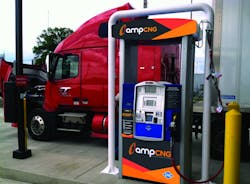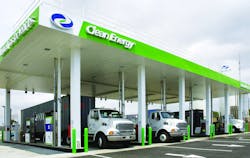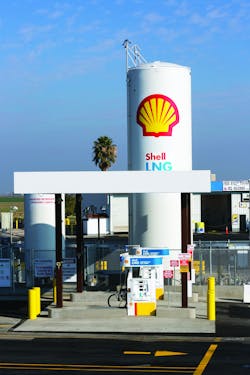If you asked ampCNG CEO Grant Zimmerman two years ago how many new compressed natural gas (CNG) fueling stations he thought the company would have built this year, he’d have told you 15. But things aren’t exactly working out the way he planned.
Though the provider is indeed expanding and has plans to build more stations in the near future, the current pace is slightly slower than expected. This year, ampCNG plans to add five fueling stations to its network of 19 public access stations dedicated to serving commercial fleets. Zimmerman says the company plans to increase the pace of stations each year starting in 2017.
Why the slight slowdown?
Zimmerman says it’s partly because adoption of CNG has slowed due to lower diesel fuel prices. However, he adds that he is optimistic about future growth since the fleets already running CNG are continuing to invest.
“I’m really encouraged by the strength of the market given the low diesel prices,” Zimmerman tells Fleet Owner. “And in the last six months, diesel is up 80%.
“CNG continues to be at lows even historically,” he adds. “I think we touched a 22- or 25-year low in the last couple of months. A barrel of crude is 25 times the cost of natural gas.”
As of June 1, the cost for a barrel of crude oil was just under $50. According to the U.S. Energy Information Agency, the industrial price of natural gas is $3.54 per thousand cu. ft., or $0.47 per diesel gallon equivalent. Nationally, diesel is averaging $2.282/gal.
And there’s more good news for the natural gas network in the U.S. Matthew Godlewski, president of NGVAmerica (Natural Gas Vehicles for America), explains that in the last five years, the network has more than doubled, and from the looks of it, it’s only going to continue to grow.
Godlewski says that natural gas station growth has been persistent with about 10 to 12 stations—both CNG and liquefied natural gas (LNG)—being built per month. He projects more than 100 new stations nationwide will open this year.
“We’ve come a long way,” Godlewski says. “The growth over the last five years has changed the dynamic and the hurdles that come with new technology and infrastructure, which are becoming less of an issue every year.
“There have been lots of peaks and valleys in the industry relative to petroleum prices,” he adds. “It’s something we’re pretty used to. The only sure thing about petroleum prices is they’ll rise and fall again. There are a lot of inconsistencies.”
The current network
CNG is used on all vehicle classes, from passenger cars to heavy-duty trucks, while LNG is typically used only on high-mileage, high-fuel-use vehicles such as long-haul trucks. According to NGVAmerica, the CNG station network today supports local vehicle operations and regional trucking in many parts of the country. The group adds that LNG stations are being constructed along America’s Interstate highways for long-haul trucking operators and that many stations are already built; they’re just awaiting sufficient demand to open.
There are now 1,640 CNG and 123 LNG natural gas stations operating in the U.S., with little more than half open to the public, according to NGVAmerica data. There are nearly 153,000 natural gas vehicles on America’s roadways, and the majority of the 39,500 natural gas heavy-duty truck sales are for CNG vehicles. Godlewski adds that though there are fleets running LNG vehicles, the trend has been that more vocational, refuse and transit have all been CNG vehicles.
“LNG is a very viable fuel,” he explains. “We are seeing a lot of potential for growth with LNG in rail project applications and a number of marine projects. I think the future for LNG growth is pretty strong in the over-the-road segment, but there is more of a bias for CNG right now.”
So where is the highest concentration of natural gas stations?
According to the U.S. Dept. of Energy’s Alternative Fuels Data Center, California currently has the most public-access CNG stations with 169 and 17 LNG stations. Oklahoma comes in second for CNG with 97 public sites, but only one LNG station. Texas rounds out the top three states with 82 CNG stations and 14 LNG sites.
Compressed natural gas
For ampCNG, most of its stations reside in Texas, Zimmerman says. The provider has seven of its 19 stations in Texas, and it began building its network in the Lone Star State to fit the needs of a major customer. Plus, according to Zimmerman, it doesn’t hurt either that the state has grant opportunities and incentives for purchasing natural gas vehicles and sites.
Zimmerman says ampCNG has applied for several grants to build more stations across the country, and because of Texas’ incentive programs, the provider applied to build five more stations in Texas alone. In addition to projects already in the pipeline, ampCNG is working on expansion projects in California, Georgia, Florida and Ohio.
From his perspective, Zimmerman says besides California, other states with a higher concentration of CNG fueling stations are Ohio, Colorado, and Pennsylvania, as well as emerging southeast states Florida and Georgia, which have 25 and 24 sites, respectively.
He also explains that when considering new stations, ampCNG tends to work with its customers rather than build stations hoping the fleets will come to them. A lot of the company’s focus also goes into the needs of the anchor customer and the area surrounding where a project was started, he adds. And for ampCNG, when it comes to building stations, spacing hasn’t really been a problem because most natural gas vehicles now are spec’d to run long distances, Zimmerman says.
“I don’t feel limited on spacing,” he says, noting that the company’s own fleet can get about 6.3 mpg on CNG. “If a customer has a long-haul route, we will try to space the stations along the way so there’s not too much variation in the distance, and so we know how to spec the trucks in the long run. The best fleets for CNG come home every night. You know exactly where the truck is going to be. They’re on a dedicated route.
“For them it’s about having a station where they need it,” he adds. “We’re building for the trucks that fit and benefit from CNG the most. The network is growing as a result. We’re at a place where the public fueling network is dense enough that you can kind of run all over the country on CNG without necessarily having to have your own dedicated stations everywhere.”
In addition to ampCNG, provider Trillium CNG, a Love’s company, has 67 CNG stations coast to coast—28 of which are public access, Class 8 locations. According to the company, its network is in the process of expanding with 30-plus locations now in the build phase.
Love’s Travel Stops & Country Stores also has 17 public access CNG fast-fill locations that accommodate Class 8 trucks. The company expects to build two more CNG locations (in Guthrie, OK, and Seguin, TX) that will serve heavy trucks.
Liquefied natural gas
On the LNG side, in the United States, Shell currently operates six LNG fueling lanes in Texas, Louisiana and California. Carson Greer, general manager of national accounts at Shell, says Travel Centers of America and Shell have entered into an agreement to further develop a network of LNG refueling stations across the country.
Though it hasn’t yet gained the same momentum CNG has, Greer says LNG has the potential to offer fuel cost savings and can help reduce well-to-wheel greenhouse gas emissions. Moreover, LNG can also reduce sulfur emissions, particulates and nitrogen oxides compared to diesel and heavy fuel oil, he adds.
Greer also explains that the development of LNG as a fuel will depend on several factors, including infrastructure, the right regulatory framework to foster growth, and a solid business case for customers to invest in new vehicle technology, engines and/or modifications to their existing fleets and vessels.
“We also recognize it will take time and effort to develop a mature LNG network for the transport market,” he tells Fleet Owner. “However, this effort is justified by the benefits: a source of cleaner and affordable energy for powering ships, heavy-duty trucks, and trains.”
One advantage Shell believes LNG has over CNG is its energy density—trucks fueled by LNG can travel longer distances. Unlike CNG, which is derived from pipeline gas from a local utility and compressed at stations on site, LNG stations typically rely on LNG that is produced off-site at dedicated liquefaction facilities and that is then trucked in and stored for use at the station.
“We anticipate continued growth of LNG as a primary fuel in the long-haul heavy-duty sector,” Greer says. “Shell has a globally strong position in LNG, technically and commercially, and we remain confident that LNG will become a bigger part of the global fuel mix.”
Future outlook
As natural gas fueling stations and infrastructure continue to expand throughout the nation, so, too, will the opportunities for fleets and other consumers to buy more natural gas vehicles.
Today, there are 153,000 natural gas vehicles on America’s roadways, and according to NGVAmerica, that number is steadily growing. Here is a snapshot of the organization’s natural vehicle count for light-, medium-, and heavy-duty vehicles:
◗ 39,500 heavy-duty vehicles, including transit buses, shuttles, school buses, refuse trucks, and port and regional-haul trucks
◗ 25,800 medium-duty vehicles
◗ 87,000 light-duty vehicles (fleet and consumer use vehicles)
Godlewski mentions that technologies for retrofitting older diesel engines to run on natural gas also abound. He adds that new NOx-reduction engines are coming out cleaner than the current standards, and that these vehicles are being deployed in parts of the country with major smog problems; for instance, California, Texas and the East Coast. He’s also noticed that many fleets that began experimenting with natural gas as a “science project” have now mainstreamed their operations and ended up fully converting to natural gas.
As to the “peaks and valleys” within the natural gas network caused by fluctuating petroleum prices, Godlewski remains optimistic. He says natural gas brings with it the long-term stability that diesel doesn’t.
“Petroleum prices are hard to predict,” Godlewski explains. “But we’ve continued to see consistent growth. The long-term value of natural gas hasn’t changed, and the environmental story is important. That points to more station growth and more deployment of [natural gas] vehicles. It’s just how rapid that will be in terms of where petroleum prices are. That’s the only unknown.”
And that is the same unknown that both CNG and LNG providers are keeping an eye on as well. The moral of the story is that as long as fleets continue to invest in CNG and LNG, providers will work with their customers to expand the natural gas network across the nation to keep the trucks that need it moving.
About the Author

Cristina Commendatore
Cristina Commendatore is a past FleetOwner editor-in-chief. She wrote for the publication from 2015 to 2023.



